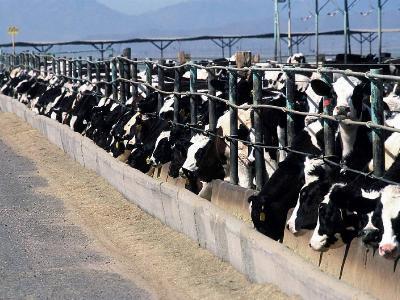5 steps to increase dairy cow dry matter intake

Increasing dry matter intake in milk cows is a measure of success for any dairy nutritionist, and this five-step program provides a basic guideline towards this goal.
In dairy cattle nutrition, any possible increase in dry matter intake (nutrients) is associated with higher milk yield. In general, and assuming a well-balanced ration is offered, an increase in dry matter intake of 1 kg per day results in about 2 kg extra milk. However, increasing dry matter intake beyond daily voluntary intake is rather difficult. There are steps to be taken at the farm level, regarding animal and feed management, but there are aspects of this problem that can be addressed while designing a dairy nutrition program. Below are five steps to push dry matter intake upwards by nutrition intervention strategies during feed formulation.
1. Use forages of higher quality
Gut capacity has a physical limit, beyond which feed intake ceases. Thus, to increase nutrient intake within the limits of physical capacity, ingredients of the highest nutrient value must be used. As grains and fats cannot be used freely to increase nutrient intake (due to metabolic disorders), it is only through forage quality that we can maximize ration nutritive value. To this end, forages with a net energy value above 1.3 Mcal/Kg are essential to enhance dry matter and nutrient intake. Corn silage is rich in energy, whereas alfalfa is slightly above the required level. Other forage materials are either borderline or below the mark.
2. Avoid metabolic disorders
Cows suffering from metabolic disorders (acidosis, ketosis, milk fever, etc.) will respond to feed intake in the same manner as sick animals: they will invariably reduce their daily intake. Thus, it pays to take any and all measures to ensure lactating cows do not suffer from such disorders, which are usually prevented by proper diet design and feeding management.
3. Limit fat in fresh cows
Following calving, cows will invariably mobilize body fat to sustain milk production, regardless of feed availability and quality. This mobilized fat increases circulation of non-esterified fatty acids, the same way as adding extra fats in the feed. The physiological response of cattle to such elevated amounts of fat catabolism components is to decrease feed intake. If the ration contains added fat, then fresh cows will respond by reducing feed intake, as they cannot stop body fat mobilization. This is particularly important in first parity cows.
4. Condition cows pre-calving
Peak milk yield proceeds peak dry matter intake by at least 5 to 10 weeks. This means early lactation is supported by body fat reserves, as dry matter intake cannot match requirements. To reduce the amount of body fat mobilization and enhance dry matter intake in fresh cows, pre-calving conditioning is recommended. This is achieved by using a transition diet about three weeks before calving. Such diet should be rich in fermentable carbohydrates to stimulate rumen absorptive capacity and increase rumen volume. It also helps reduce the incidence of ketosis at calving, which also affects dry matter intake.
5. Use additives that balance rumen functioning
There are not many additives that work predictably in conditioning rumen functionality. This is because each additive depends on the conditions created by the total ration consumed by the cow and her physical and health condition. Thus, each additive must be evaluated on a farm-specific approach. In general, sodium bicarbonate, yeast and yeast derivatives are the most commonly used additives. Others, less frequently used include enzymes, probiotics, clays, algae and different salts. It should be noted that the use of additives is secondary to balancing the ration. Additives should be used to enhance dry matter intake and not fix problems created by improper ration design.
In brief
Presumably, an attending nutritionist already takes care of the above issues, but quite often, for cost saving reasons, some corners are cut. Such is the case when feedstuffs become extremely expensive. But, care should be taken to return to maximal milk yield potential when such exercise becomes again profitable. Modern dairy cows have a tremendous capacity for milk yield, and it is to our benefit to provide them with the best possible nutrition to ensure they express their full genetic potential.
Ioannis Mavromichalis, Ph.D., is Nutrition Editor for WATTAgNet and Editor-in-Chief of Pig International
Có thể bạn quan tâm
 EU dairy industry milk crisis impacting feed production
EU dairy industry milk crisis impacting feed production Compound feed producers feel pain of dairy surpluses since the end of EU milk quota system.
 How feed efficient is your dairy cow?
How feed efficient is your dairy cow? Dairy farmers in the Netherlands can find out the feed efficiency of the offspring of sires values that are included in the breeding value and could contribute
 Total mixed ration system for dairy cows: benefits, drawbacks
Total mixed ration system for dairy cows: benefits, drawbacks The many benefits of total mixed ration are weighed against their disadvantages for farmers to decide whether such feeding system is for them to adopt.